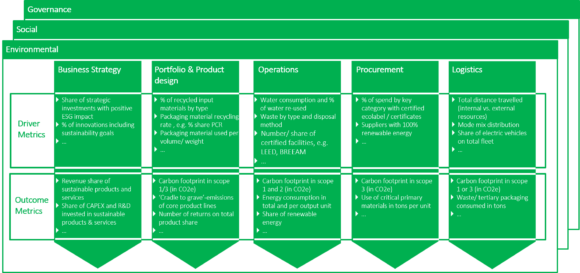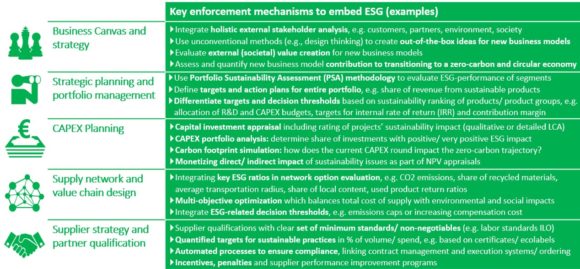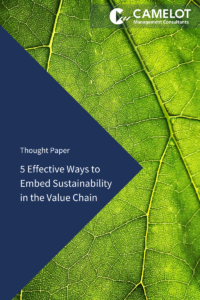In the past years, many companies have dedicated significant efforts to improve transparency and performance in the environmental, social and governance (ESG) area, and launched many initiatives to respond to the pre-eminent climate crisis. However, to truly address the magnitude of the challenge and become frontrunners in a low-carbon economy, companies need to deeply embed sustainability in the heart of their business operations, including performance management, organization, and day-to-day decision making.
In our first article, we highlighted the urgency of immediate action to reduce carbon emissions and make the economy more sustainable. To become a leader in this transformation process, organizations need to build a sustainable business and value chain in an agile and bold way. We have provided a framework for how to embed sustainability into the core of an organization, starting from the key management processes and decisions with the highest impact on ESG, followed by effective enforcement mechanisms in these core processes (Figure 1).
Figure 1: Enforcement mechanisms to embed ESG in core strategic management processes
To complement the framework, it is vital to embed ESG into performance management by reporting and monitoring the right metrics, and into the operating model by anchoring ESG in the organization across all key business areas.
People, Planet, Profit – How to embed ESG into performance management
To substantially integrate ESG criteria into decision-making, they need to become an integral part of performance management systems for management and employees. The first step is to bring ESG performance metrics from the world of external sustainability reporting to the center of internal performance management and steering concepts, both on the financial and operations level. This follows the triple bottom line approach introduced in the 1990s, which provides a comprehensive finance and accounting framework based on social, environmental and financial elements.[1] Second, companies need to set up and continuously expand their KPI systems with environmental, social and governance metrics for all key impacted functions. KPIs should include both outcome metrics (e.g., emissions per ton in production) as well as critical driver metrics in line with key improvement areas on the path to climate neutrality (e.g., share of recycled input materials in a certain product line). And third, companies need to focus on enhancing the agenda of core performance management meetings and reviews on a monthly or weekly basis, ensuring that ESG-related challenges become an integral part of these dialogues and trigger the same collaboration, problem-solving, and creativity applied to managing pressing business issues.
 Figure 2: Performance Management System for ‘Environmental’ (as part of ESG)
Figure 2: Performance Management System for ‘Environmental’ (as part of ESG)
Figure 2 gives an overview of what an ESG-based scorecard can look like. Of course, it needs to be designed individually to fit the organization’s business model and take into account for its specific situation. For the performance management system to be successful, the metrics must be calculated on a recurring base, drilled down, and allocated to different business areas and departments, and shared within the entire organization so that visibility of the data begins to drive behavior. Additionally, employees should be compensated and bonuses should be granted based on environmental and social performance. One example is the technology company Apple, which recently announced to incorporate environmental, social and governance elements into their annual cash incentive program.[2]
The framework above is intended to be used for annual target setting beyond carbon reduction targets (e.g., reduction of water use) and applied retrospectively to track ongoing efforts against individually set targets on a business unit, function, or corporate level.
The next horizon is to fully integrating ESG aspects into ERP systems, to a degree that every granular transaction is automatically linked to a quantified carbon impact. This will allow a new level of footprint analysis at the product level and detailed optimization of natural resources use in end-to-end processes like design to operate, lead to cash, and source to pay. SAP’s Climate 21 initiative follows this vision of embedding sustainability as a new dimension of success in analytical and transactional applications to optimize resources across value chains and the entire lifecycle.[3]
Self-governing operating model with strong focus on community and ecosystem
The organizational basis for sustainable management should be guided by several perspectives. First, sustainability needs to be set up not as a single function, but as an operating principle across the entire organization. Thus, a hybrid organizational model is typically preferred, consisting of sustainability advocates and subject matter experts embedded in all key business units and functions (owning and implementing individual initiatives), and a central sustainability group reporting to the CEO (driving target setting, consolidating and exchange, providing standards and tools, training employees, and linking with strategy and other functions).
The key focus of the sustainability operating model is to embed the right degree of resources, expertise and change management to make a difference in each key business area. Take the procurement function as an example: which resources and capabilities are needed in category management, business partnering, technical support, and procurement operations to continuously develop and implement new concepts that help achieve the sustainability targets for scope 3? Building on a solid representation of sustainability skills in key business areas, the focus should be to create a self-governing approach, with a cross-functional environment and community that enables continuous learning, information sharing, experimentation, and effective collaboration in cross-functional teams.
Lastly, the operating model should be outward rather than inward oriented, with a strong focus on building an external ecosystem of sustainability partners such as customers, suppliers, universities, technology and solution providers, and others. External sustainability advisory boards or expert panels are strong instruments for linking the external ecosystem with decision makers in the organization on different levels.
How to start the change: 10 key questions you should address as a CEO
While change towards a low-carbon economy is increasingly important for all employees and becomes a critical factor for talent acquisition and retention, the changes in core strategic decision making described above need to start with the management team. How can CEOs and other executives effectively drive change and become the engine to establish the awareness, buy-in, expertise, tools, processes, and ways of collaboration that enable sustainable management? From our experience, it is important to ask the right questions to spur action, either in self-reflection or in dialogue with the team:
- What are our specific sustainability targets for the next years? How do they break down by each contributing business unit or function?
- What is the share of sustainable products and services in our portfolio? What is our strategy to expand them, prioritizing R&D and marketing spend as well as capital investments accordingly?
- What share of our capital investments are making a positive contribution to our sustainability agenda?
- How does the CAPEX portfolio impact our carbon emissions reduction plan?
- Do we have sufficient know-how and resources in the finance & controlling team to drive towards integration of sustainability into planning and budgeting?
- How could we transform our value chain and supply network to make outsized contributions to our sustainability footprint? How to include these scenarios in our operations strategy?
- What is the sustainability footprint of our supplier base, e.g., scope 3 emissions, water, waste? What level of transparency and understanding do we have on key drivers?
- Do we effectively inform our supplier management based on ESG-criteria and targets? Do we have specific targets for key drivers, e.g., share of recycled/ secondary material use in certain categories?
- Does the procurement and quality function have sufficient know how and resources to transform the sustainability footprint of the supplier base?
- Do we have the right external partnerships and ecosystems in place to challenge existing ways of working and link with the latest innovations?
To become leaders in the low-carbon economy, companies need to go beyond driving a portfolio of aspirational initiatives and deeply integrate ESG into the core management decision-making processes. Deeply embedding sustainability and ESG into core processes such as business model innovation, portfolio planning, CAPEX planning, and sourcing strategy is the key next hurdle, and overcoming it brings an extraordinary return on investment. Rather than investing millions, it’s about building awareness, buy-in, and skills within the management team and direct reports, and leveraging new approaches to better make day-to-day decisions from the perspective of external and societal value creation.
[1] https://www.economist.com/news/2009/11/17/triple-bottom-line.
[2] https://www.reuters.com/article/us-apple-compensation/apple-will-modify-executive-bonuses-based-on-environmental-values-in-2021-idINKBN29A2MK.
[3] https://www.climateaction.org/climate-leader-interviews/thomas-saueressig-sap-se-on-can-software-realign-us-with-the-goals-of-the-p.
We would like to thank Florian Kreitz for his valuable contribution to this article.


